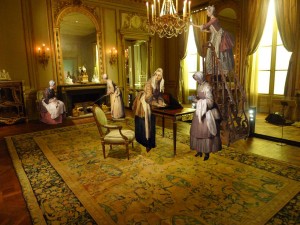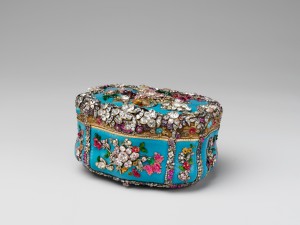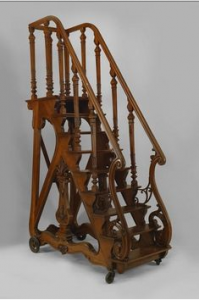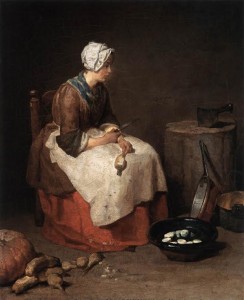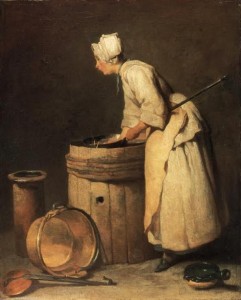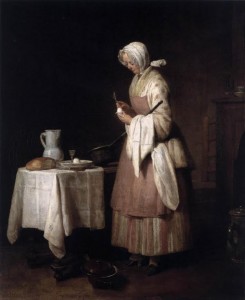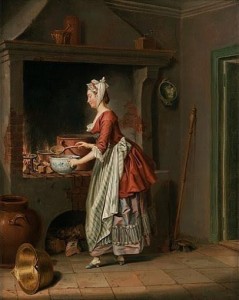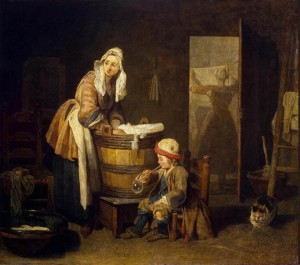Composite picture of the Metropolitan Museum of Art Tessé Room by Heather Nickels, showing how many servants would have been at work in such a room in the morning, and at what tasks: replacing candles, filling desk inkwells, cleaning out the hearth from the night before, mending, polishing, and dusting the snuff boxes, furniture and chandeliers. One servant, exhausted from her work, sits in the corner, as the servant in the center looks on, clearly irritated.
More often than not, a domestic space like the Tessé Room would have been occupied by servants in lieu of owners, or masters. Frequently, these familial interiors were solely occupied by servants, whose occupations would be performing their daily duties, such as polishing metalware, dusting the chandelier or fireplace, or preparing for the next meal. In most upper-class and royal households, the number of servants outnumbered the owners; for example, in one aristocratic household of six in Toulouse, France at the end of the 17th century – beginning of the 18th century, there were fifty-three servants [1].
When discussing 18th century French domesticity, ideas of fidelity and loyalty played a huge role in defining the relationship between masters and servants. In addition, privacy, as we know it today, did not yet exist during the 18th century in France, or in Europe as a whole; no matter where one was within these domestic spaces, someone else – a servant – would always be within reach.
Items added to the PhotoShopped Image of the Tessé Room:
Snuff boxes were small, often ornamented boxes that contained “snuff,” a form of powdered tobacco common during the 17th and 18th centuries in Europe, places like England and France. People often would inhale the powder, which would then provide them with a sensation or a kind of temporary high. These boxes were often exchanged as gifts or traded in lieu of liquid currency; as they were often made of luxurious materials, they were often extremely expensive. For more information on snuffboxes, look at the section on snuffboxes on our sister site, “Materials and Their Makers”: https://bt.barnard.edu/ave2015/project2/.
Jewelled Snuffbox
Date: ca. 1765
Culture: German, Berlin
Medium: Glass, gold, silver, diamonds and rubies
Dimensions: H. 6 cm, L. 10 cm, D. 8.8 cm
Classification: Snuffboxes
Credit Line: Robert Lehman Collection, 1975
Accession Number: 1975.1.1536
On view in Gallery 951
This bejeweled blue snuff box was thought to be commissioned by Frederick II of Prussia between the years of 1742 and 1775. About 125 of these boxes, called the “Potsdam boxes,” were created for the King, and unfortunately, only about 25 of them have survived to this day. Art historians have attributed these “Potsdam boxes” to the English-born artist Jean Guillaume George Krüger (1728 – 1791). This particular snuff box has a glass frame, which is rather unusual for snuff boxes of its time, and within the collection of 125 snuffboxes commissioned by the King.
The ladder, on which one of the servants stands, dates back to the 18th century.
A broom was also added from this painting, “A Pause at the Piano,” which one of the servants uses to sweep the chimney from the fireplace, which was used the night before.
Characters Added to the Tessé Room
Jean-Simeon Chardin
French, 1699 – 1779
The Kitchen Maid
1738
oil on canvas
overall: 46.2 x 37.5 cm (18 3/16 x 14 3/4 in.)
framed: 61.9 x 53.7 x 7.3 cm (24 3/8 x 21 1/8 x 2 7/8 in.)
1952.5.38
Jean-Siméon Chardin
French, 1699–1779
The Scullery Maid
1738
oil on canvas
18 1/2 x 15 inches
William A. Clark Collection
26.39
Jean-Simeon Chardin
French, 1699 – 1779
The Attentive Nurse, 1747
oil on canvas
overall: 46.2 x 37 cm (18 3/16 x 14 9/16 in.) framed: 61.9 x 53.7 x 7.3 cm (24 3/8 x 21 1/8 x 2 7/8 in.)
Samuel H. Kress Collection
1952.5.37
Pehr Hillestrom (1732-1816)
Swedish
En piga höser såppa utur en kiettel – i en skål (A maid is pouring soup)
1770
Relined canvas
Dimensions 21.85 X 17.91 in (55.5 X 45.5 cm)
Private collection
Jean-Simeon Chardin
French, 1699 – 1779
The Laundress
1730s
Oil on canvas, 38 x 43 cm
The Hermitage, St. Petersburg
